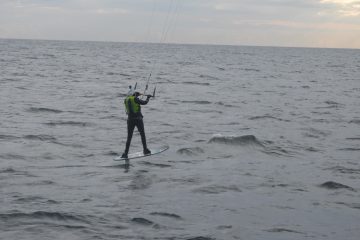Depending on how strong the wind is, you may want to use a different size kite. Kites are measured in square meters, however when you see this written or verbalised, the “square” is oftem omitted. For this trip we have PeterLynn kites ranging from 5m2 to 15m2. The bigger the kite, the more powerful it is, and usually the less wind you need to fly it. Below are some factors to consider when choosing which kite size to use:
Wind Speed
As hinted above, the strength of the wind is the biggest factor in choosing which kite to use. Too big a kite in too strong a wind will mean the rider is over powered, possibly resulting in the kite pulling them over forwards and crashing more. Too small a kite, and the rider may not be able to get onto the board to ride.
Rider’s Weight
The heavier you are, the more power or energy you need from the kite to lift yourself up off the water. To achieve this you move the kite in a large “power stroke”. The process of standing up is usually when you need the most energy from the kite. Stew and Islay are approximately 20kg apart, so on twin tips they will usually be on kites 2m2 apart. (Does mean neither of us can gain/loose weight without the other doing the same).
Sea State
If it’s flat calm on a twin-tip board you can hold a lot more power than in rough seas, as you can really lean back, using your body as a lever to counteract the power (known as holding your edge). In rough seas this is harder to do, as if you lean too far back a wave can come and dunk you in. Similarly, too depowered in waves means you may start sinking as try to ride up and over a wave crest.
Board choice
If riding a twin-tip, you generally need slightly more power than on a foil. This is because once a foil is out of the water there is very little friction, so less power is needed. In our blogs, we’ll sometimes mention changing board types intra-day. This is because it is faster than changing kite sizes. If we are slightly overpowered on our foil-boards, we can change to the twin-tips and the extra friction from the boards being in constant contact with the water means we can handle more power. (We’re also more experienced on our twin-tips).
Quiver Size
Which kite you use will also depend on what you have. Most riders will have a quiver of two kites. A common quiver for the south coast of England would be a 12m2 and a 9m2. These sizes are far enough apart that the wind range of the two kites won’t overlap too much while not having too big a gap between them. Depending on where the rider’s local spots are they may want a different set. For example, in Nassau (Bahamas) the wind is usually lighter, so the same person may instead choose to have larger kites in their set, e.g. possibly a 15m2 and a 12m2
